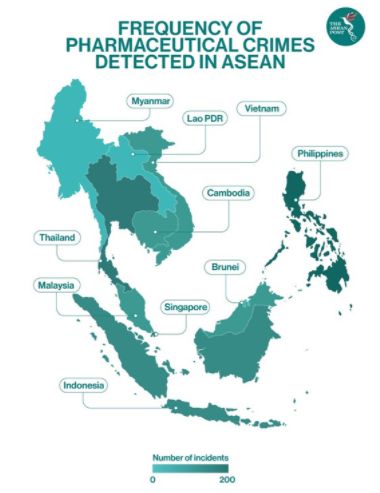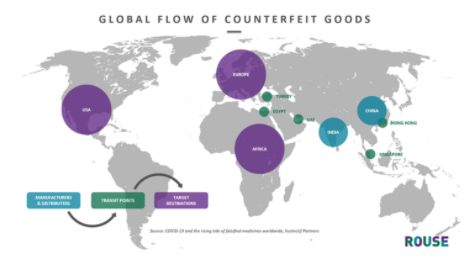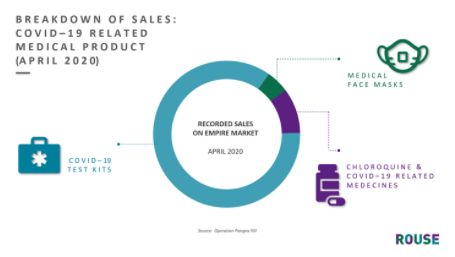- within Finance and Banking and Privacy topic(s)
- with readers working within the Retail & Leisure industries
A time to reflect and envision the impact of the pandemic on the flow of counterfeit goods and others.
2020 was a tumultuous year globally. As the new year brings hope for an effective COVID-19 vaccine rollout, it is important to reflect on the impact of the pandemic on the flow of counterfeit goods globally and the various health concerns associated with counterfeits that it has highlighted.
The onslaught
In response to the evolving situation, many countries last year announced lockdowns in varying degrees, thereby disrupting genuine manufacturing and global supply chains. This unexpected turn of events led to the shortage of essential products such as clothing, food, and medicines. The supply of genuine pharmaceutical products was heavily affected, with several companies from the industry operating at 50-60% of their normal capacity and raw materials depleting faster than usual to meet the increasing demand without adequate supplies. The COVID-19 crisis created a lucrative environment for counterfeiters to quickly meet the demand with fake, sub-standard products.

Even before the pandemic, counterfeits in the healthcare sector have been a concern, especially in the developing regions such as Africa and ASEAN.
There is no doubt that the COVID-19 pandemic has added new and alarming trends to the pre-existing issue with the rise of counterfeit medical personal protective equipment ('PPE'), other medical supplies and now the looming threat of fake vaccinations reaching the end consumer.
The tremendous growth in global e-commerce has 'fuelled the fire', demonstrated by the speed and depth at which counterfeiters were able to quickly infiltrate supply chains. This was further accelerated by wide-scale restrictions and apprehension among buyers to visit physical stores.
Infringers quickly adapted to the shift in shopping behaviour from offline to online and soon online avenues (marketplaces, illicit websites, dark web market and social media platforms) experienced a spike in availability of COVID-19 related counterfeits and scams through phishing emails.
Covid-19 Counterfeits flooding the market
As per the US Customs and Border Protection report, most counterfeit goods seized in 2020 in relation to COVID-19 were from China and were destined for markets in the USA, Africa, and Europe.

Data: The US CBP said that the products were shipped from manufacturers and distributors in China, Hong Kong, South Korea, Turkey, Saudi Arabia, Nigeria, Senegal, Germany, and the United Kingdom and were destined to addresses in Pennsylvania, New Jersey, Delaware, Virginia, Connecticut, and Florida.

This onslaught of counterfeit COVID-19 related goods were predominantly in the form of counterfeit testing kits, the numbers of which dwarf any other form of COVID-19 related counterfeit product. New concerning trends are expected to emerge with the vaccination in sight.
The pace and ease of infiltration of legitimate supply chains with counterfeit PPE and medical products triggered a global response by authorities. In Vietnam, authorities started investigating and seizing counterfeit masks and hand sanitisers as early as Feb 2020, and by March 2020, special task forces were created to tackle illicit online sale of medicine and medical products.
The clean-up
The pace and ease of infiltration of legitimate supply chains with counterfeit PPE and medical products triggered a global response by authorities. In Vietnam, authorities started investigating and seizing counterfeit masks and hand sanitisers as early as Feb 2020. By March 2020, special task forces were created globally to tackle illicit online sale of medicine and medical products.
INTERPOL's Operation Pangea XIII initiated a global effort in March 2020, after observing a rise in fake medical products related to the COVID-19 outbreak. Participating authorities seized over 4,4 million units of counterfeit masks, substandard hand sanitizers and unauthorised antiviral medication worth USD 14m. The operation has resulted in 141 arrests and more than 2,500 websites were taken down.
The US ICE Homeland Security Investigation Agency cranked up their efforts on the front-line too - their operation ('Stolen Promises') launched in April 2020 was incredibly successful. It led to seizures of over USD 29m in illicit funds, shut down over 10,000 websites and made numerous arrests - one target trying to sell over 125 million counterfeit face masks and PPE worth USD 750m across the USA.
In terms of education, information-sharing initiatives and lobbying, authorities worldwide have been on the ball. Public alerts have been issued in 2020 by the WHO, WCO, The US Food & Drugs Administration amongst others, warning of the dangers of purchasing and using counterfeit products. INTERPOL's global alert in December 2020 to law enforcement across its 194 member countries warned them to prepare for organized crime networks targeting COVID-19 vaccines, both physically and online. This alert comes on the back of a police raid in November 2020 in South Africa which busted an operation and seized a large quantity of counterfeit N95 safety masks and illicit and unregistered COVID-19 vaccines.

Many rights holders have also stepped up to the plate. Industry leader 3M is just one of the many companies who are actively chasing down and bringing action in various jurisdictions against those manufacturing and selling counterfeit PPE products.
Tackling the storm
So what can be learnt from the activities of the counterfeiters last year?
- Complicated transborder supply chains and the growing role of ecommerce in retail sales has left rights holders more vulnerable than before. It is being strongly argued that right holders can rise to the challenge by maintaining local shortened supply chains through nearshoring (or reshoring) which are easier to maintain. This coupled with leveraging new technology could to bring much-needed transparency to the supply chain.
- The internet being a gateway to counterfeits reaching consumers is nothing new. However, the pandemic has given rise to a dramatic increase in those sales. Ecommerce regulations in many developing countries are still evolving, giving unscrupulous third-party sellers a golden opportunity. Better cooperation between rights holders, intermediary service providers and authorities in those developing countries is required to develop offensive brand protection strategies to stop these counterfeiters in their tracks quickly.
- Free Trade Zones (FTZ) continue to deserve some attention. There is strong evidence globally that FTZs are conduits for counterfeit trade which flow through them largely undetected due to a lack of proper governance of the businesses that operate through them. Although the Organisation for Economic Co-operation and Development had adopted a formal recommendation to enhance their transparency in October 2019 pre the pandemic, it has not been able to get much traction yet.
- Governments must continue to assess how anti-money laundering provisions can be more easily integrated and promoted to tackle counterfeits and proceeds of crime within local enforcement mechanisms.
The COVID-19 pandemic and the counterfeiters' response to it has highlighted to authorities and right holders the need for a more responsive, sophisticated and ever-evolving anti-counterfeiting strategy. Tackling the scourge of counterfeits can never be static.
References:
- https://cleanroomtechnology.com/news/article_page/Manufacturers_of_counterfeit_DuPont_PPE_receive_jail_sentence/172092
- https://www.iracm.com/en/2020/07/mexique-fake-plaquenil-uncovered/
- https://www.baltimoresun.com/coronavirus/bs-md-fake-coronavirus-medications-seizures-20200511-ezodjdqqevde5ibkdedsrezn24-story.html
- https://www.interpol.int/en/News-and-Events/News/2017/Millions-of-medicines-seized-in-largest-INTERPOL-operation-against-illicit-online-pharmacies
- https://www.cnbctv18.com/politics/govt-begins-pan-india-drive-to-check-sale-of-spurious-unapproved-hand-sanitizers-6336161.htm
- https://bc.ctvnews.ca/someone-is-selling-268-sanitizer-through-walmart-marketplace-1.4800114
- https://www.glossy.co/fashion/the-rise-of-the-fake-designer-mask/
- https://ktla.com/news/counterfeit-covid-19-medication-test-kits-face-masks-seized-in-washington-d-c/
- https://www.interpol.int/en/News-and-Events/News/2020/Global-operation-sees-a-rise-in-fake-medical-products-related-to-COVID-19
- https://www.indiatoday.in/fact-check/story/covid-19-testing-kit-fact-check-coronavirus-1658750-2020-03-23
- https://www.enca.com/news/police-seize-fake-covid-kits-international-trafficking-crackdown
- https://www.bbc.com/news/health-52201077
- https://bringmethenews.com/minnesota-news/3m-sues-florida-company-that-sold-10k-counterfeit-n95-masks-to-hcmc
The content of this article is intended to provide a general guide to the subject matter. Specialist advice should be sought about your specific circumstances.


